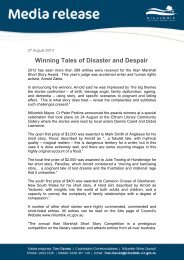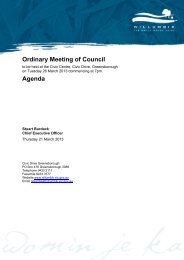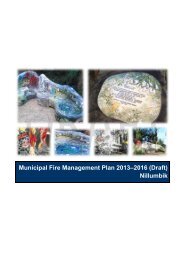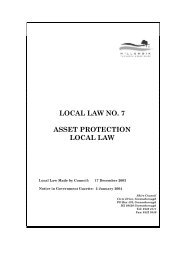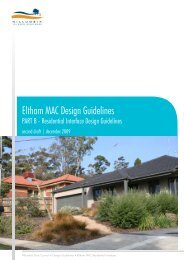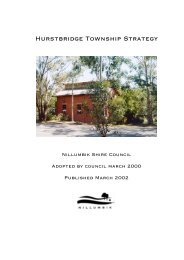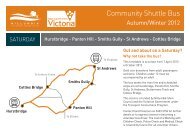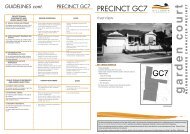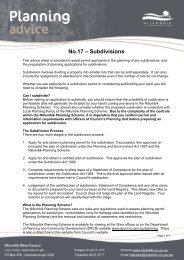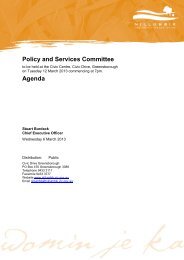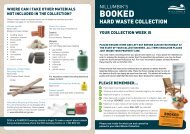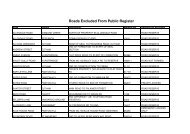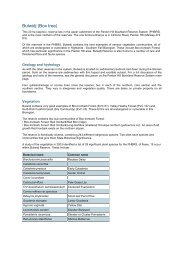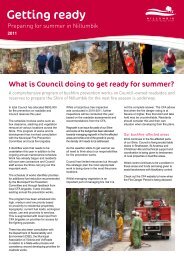Sustainable Water Management Plan - Nillumbik Shire Council
Sustainable Water Management Plan - Nillumbik Shire Council
Sustainable Water Management Plan - Nillumbik Shire Council
Create successful ePaper yourself
Turn your PDF publications into a flip-book with our unique Google optimized e-Paper software.
APPENDIX E<br />
Conventions, Agreements, Legislation, Policies,<br />
Strategies and <strong>Plan</strong>s linked to the <strong>Sustainable</strong><br />
<strong>Water</strong> <strong>Management</strong> <strong>Plan</strong><br />
International agreements<br />
The World <strong>Water</strong> Development Report<br />
The World <strong>Water</strong> Development Report (2003) is<br />
an ongoing assessment project undertaken by the<br />
World <strong>Water</strong> Assessment Program Committee.<br />
The international community pledged to halve the<br />
proportion of people who are unable to access<br />
or afford safe drinking water by 2015 and to stop<br />
the unsustainable exploitation of water resources,<br />
through the development of water management<br />
strategies at the regional, national and local levels.<br />
Federal Government<br />
National <strong>Water</strong> Initiative<br />
The National <strong>Water</strong> Initiative (NWI) was signed by<br />
the Coalition of Australian Governments (COAG)<br />
in 2004. The NWI aims to achieve a nationally<br />
compatible market, regulatory and planning based<br />
system of managing surface and groundwater<br />
resources for rural and urban use that optimises<br />
economic, social and environmental outcomes.<br />
Victorian Government<br />
21st Century Melbourne: A <strong>Water</strong>Smart City<br />
– The Final Report<br />
In October 2002, the State Government released<br />
21st Century Melbourne: A <strong>Water</strong>Smart City<br />
confirming its commitment to water conservation<br />
by setting a blueprint for water resources for the<br />
next 50 years. The report recommends reducing<br />
metropolitan water consumption by 12% per annum<br />
by 2050. This will be achieved through demand<br />
management, efficient appliances, water harvesting<br />
and water reuse. The Strategy states that ‘ no new<br />
dams or diversion weirs should be built in the next<br />
50 years’ and sets out actions that will lead to a<br />
decrease in water consumption.<br />
Melbourne 2030<br />
The Victorian Government released the Metropolitan<br />
Strategy 2030: <strong>Plan</strong>ning for <strong>Sustainable</strong> Growth. Its<br />
objective for water management is to ensure that<br />
‘water use efficiency will be managed so that existing<br />
storages can reliably meet water demand beyond<br />
2030’. 9 The policy sets out initiatives to achieve this,<br />
including the promotion of water efficient practices;<br />
the preparation of guidelines to encourage the use of<br />
alternative water resources such as rainwater tanks,<br />
stormwater and recycled water.<br />
New <strong>Water</strong> for Victoria 2003<br />
This <strong>Plan</strong> provides a framework for the adoption of<br />
water recycling across Victoria as part of sustainable<br />
water resource management. It outlines the current<br />
barriers to recycling and provides a plan to deliver<br />
the government’s medium term goal to increase<br />
water recycling in Melbourne by 20% by 2010. The<br />
action plan focuses on water recycling from sewage<br />
systems operated by government-owned water<br />
businesses.<br />
Securing Our <strong>Water</strong> Future Together<br />
Securing Our <strong>Water</strong> Future Together – White<br />
Paper (2004) sets out an action plan to secure<br />
Victoria’s water future over the next 50 years by<br />
building an ethic throughout the community of<br />
water conservation. The plan proposes a wide<br />
range of actions to cut water use. Initiatives<br />
include permanent water saving measures, reuse<br />
of greywater, capture and reuse of stormwater,<br />
pricing to encourage water conservation, mandatory<br />
water rating on appliances, regulation of water<br />
saving devices, e.g. AAA showerheads, rebates<br />
for purchases of water saving devices, and water<br />
sensitive urban development. The paper also looks<br />
at restoring our rivers and streams to safeguard<br />
water systems into the future.<br />
Draft Central Region <strong>Sustainable</strong><br />
<strong>Water</strong> Strategy<br />
Regional <strong>Sustainable</strong> <strong>Water</strong> <strong>Management</strong> Strategies<br />
are a key action within the State Government’s Our<br />
<strong>Water</strong> Our Future policy. The Draft Central Region<br />
<strong>Sustainable</strong> <strong>Water</strong> Strategy is a plan to secure water<br />
supplies for homes, business, industry, agriculture<br />
and the environment for the next 50 years.It will<br />
secure water supplies for all users in the face of<br />
future pressures on the resource such as climate<br />
change, population growth, economic development<br />
and land use change.<br />
This Draft Strategy is an integrated approach to<br />
water resource planning. It considers all water<br />
sources including rivers, reservoirs, aquifers, as well<br />
as recycled water, storm water and seawater.<br />
The Central Region covers an arc around<br />
Melbourne, including Geelong, Ballarat, the<br />
Macedon district and West Gippsland. It includes the<br />
Barwon, Moorabool, Werribee, Maribyrnong, Yarra,<br />
Bunyip, Thomson and Latrobe river catchments.<br />
State Government – State of the Environment<br />
Protection Policy (<strong>Water</strong>s of Victoria) including<br />
Schedule F6: <strong>Water</strong>s of Port Phillip Bay and<br />
Schedule 7: <strong>Water</strong>s of the Yarra Catchment.<br />
The SEPPs were reviewed and released in 2003<br />
and establish the basis for maintaining water quality<br />
at a level conducive to environmental health, public<br />
benefit, welfare, health and safety; and provide<br />
an adequate basis for planning functions. SEPPs<br />
provide a framework for government agencies,<br />
businesses and other members of Victoria’s<br />
communities to work together to protect and<br />
rehabilitate Victoria’s surface water environments.<br />
State Government – Victorian River Health<br />
Strategy<br />
The Victorian River Health Strategy (2002) provides<br />
a vision for the management of rivers in Victoria and<br />
policy direction on issues affecting river health to<br />
ensure the most effective long term outcomes for the<br />
effort and resources invested.<br />
State Government – Port Phillip and<br />
Westernport Regional Catchment Strategy<br />
The Regional Catchment Strategy analyses the<br />
natural assets of the region, assesses the risk<br />
to those assets from past and current activities,<br />
and identifies priority actions for improving and<br />
enhancing the health of the region’s land, water and<br />
biodiversity.<br />
State Government – Yarra River Action <strong>Plan</strong><br />
The Yarra River Action <strong>Plan</strong> outlines priority projects<br />
that the State will implement in conjunction with<br />
local governments and the community to improve<br />
the health and amenity of the Yarra River. Actions<br />
include an upgrade of the northern sewage<br />
system, replacement of 18,500 septic tanks<br />
through connection to reticulated sewage system,<br />
litter education, development of agricultural best<br />
management practices, and ensuring the Yarra<br />
receives sufficient flows for its environmental needs.<br />
<strong>Nillumbik</strong> <strong>Shire</strong> <strong>Council</strong>’s Policies<br />
Municipal Strategic Statement<br />
<strong>Nillumbik</strong> <strong>Shire</strong> <strong>Council</strong>’s Municipal Strategic<br />
Statement (MSS) outlines the vision for sustainable<br />
land use and natural resource management in the<br />
<strong>Shire</strong>. It responds to the range of environmental,<br />
social and economic factors that shape the <strong>Shire</strong> and<br />
outlines the objectives and strategies which need to<br />
be implemented to achieve this vision.<br />
<strong>Nillumbik</strong> <strong>Shire</strong> <strong>Council</strong> – <strong>Council</strong> <strong>Plan</strong><br />
2007-2011 10<br />
The <strong>Council</strong> <strong>Plan</strong> is <strong>Council</strong>’s primary strategic<br />
planning document, defining the strategies required<br />
to achieve the <strong>Shire</strong> of <strong>Nillumbik</strong>’s vision.<br />
Strategies to achieve sustainable water<br />
management are:<br />
1.2.2 Reduce water and energy consumption<br />
at all <strong>Council</strong> facilities and more broadly<br />
across the community in residential and<br />
other premises.<br />
1.2.6 Implement programs to minimise waste<br />
water discharge and improve water<br />
quality.<br />
10<br />
<strong>Nillumbik</strong> <strong>Shire</strong> <strong>Council</strong> <strong>Plan</strong> 2007-11<br />
9<br />
Melbourne 2030: <strong>Plan</strong>ning for a sustainable growth.<br />
Direction 7, Policy 7.1: Ensure that water resources are managed<br />
in a sustainable way.<br />
54 <strong>Sustainable</strong> <strong>Water</strong> <strong>Management</strong> <strong>Plan</strong> <strong>Sustainable</strong> <strong>Water</strong> <strong>Management</strong> <strong>Plan</strong>



